I'm trying to clock a BBD (Bucket Brigade Device) circuit (for example the MN3007) from a microcontroller output. However, the circuit requires a complementary negative clock, i.e. CP1 is \$-12V\$ to \$0V\$ and CP2 is \$0V\$ to \$-12V\$ (for \$\mathrm{VDD} = -12V\$). The transition time for the clock is specified as less than 500ns, although I'd prefer to be well below that since apparently the clock signal directly drives the BBD transistors, so a slow transition increases non-linearities. Further, apparently the output should have reasonably low impedance, as the clock IC usually used with these types of BBD's (such as the MN3101) advertises about \$2mA\$ output current. Yet worse, the datasheet specifies that the clock cross point, i.e. where the the two complementary clock signals cross, should be between 0V and -3V, so a perfectly symmetrical drive won't do. One last technical requirement is that the that the clock voltages should be as close as possible to the rails, since those limit the signal swing (looking at the datasheet, the clock directly drives the gates of the switching transistors).
So, to summarize, your mission, should you choose to accept it, is to
point me to the right direction for designing a circuit that:
- Given an input clock signal 0V - 3.3V, generates a complementary pair of clock outputs with levels 0 and -12V
- transition time is less than 500ns
- The clock outputs are able to provide at least 2 mA of output current
- The levels are as close as possible to the rails (this disqualifies the most standard BJT circuit, such as discussed in this question)
- The clock signals cross between 0 and -3V: alternatively: instead of providing the complementary outputs, I'll just design a good level shifter, and I'll use two channels of MCU PWM outputs for the complementary clocks and time them to adjust the crossing level. This requires that the level shifter edge shape is predictable in production and over varying environmental circumstances.
- Price is important, 1$ per clock is already a lot (I'll be needing two of these per device, production numbers will probably be in the hundreds so parts pricing at hundreds is the correct quantity to consider)
- PCB real estate is even more important
Bonus goals:
- Using only components that can be wave soldered (due to some inevitable through hole components, we have to wave solder one side of the board, so this would give me a chance to keep all components on one side), while still keeping 5. and 6. in mind.
- Transition time is much less than 500ns.
Possible trick to use:
One way that could make life a bit easier is that I could just as well hang the BBD between the +12V and 0V rails, instead of 0 and -12V. This would mean that the clock levels would instead be +12V and 0V, and the crossing point would be between +12V and +9V.
